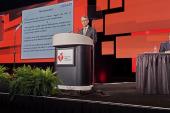CRP More Predictive of Future Events Than LDL in Statin-Treated Patients
An adjuvant anti-inflammatory might offer more protection than additional lipid-lowering, a meta-analysis hints.

NEW ORLEANS, LA—For patients already receiving statins, inflammation is more tightly linked than LDL cholesterol to future adverse events, a new meta-analysis shows. The association between high-sensitivity C-reactive protein (hsCRP) and events is so strong, in fact, researchers say it points to an alternative path for addressing residual risk.
Working together, investigators from three trials—PROMINENT, REDUCE-IT, and STRENGTH—published their findings in the Lancet last week to coincide with the American College of Cardiology/World Congress of Cardiology (ACC/WCC) 2023 meeting.
“We all understand that among treatment-naive men and women, inflammation and hyperlipidemia contribute with very similar magnitude to the risks of future atherothrombotic events, and that these two processes interact with each other to deliver atherosclerosis,” Paul M. Ridker, MD (Brigham and Women’s Hospital, Boston, MA), told attendees in a featured clinical research session at ACC/WCC.
On top of statin therapy, numerous randomized controlled trials have shown that adjunctive LDL-lowering, such as with ezetimibe or PCSK9 inhibitors—and most recently, bempedoic acid (Nexletol; Esperion)—can further reduce risk. Similarly, Ridker continued, trials have shown added benefit beyond statins when targeting the inflammation pathway with agents like colchicine or canakinumab (Novartis). This suggests “that ‘lower is better’ for both biologic processes,” he noted.
How exactly clinicians should apply this knowledge, especially when there are no anti-inflammatory drugs with US Food and Drug Administration-approved CV indications, isn’t yet clear. “This issue, however, has very broad implication for patient care, for clinical guidelines, for cost-effectiveness, and for drug development,” said Ridker.
On that basis, the meta-analysis’ authors decided to look at the relative importance of lipid-lowering versus inflammation reduction specifically in statin-treated patients. “When we started this project, we made an assumption that both LDL and CRP would be pretty equal contributors to future vascular risk. That’s not what we found, however, which surprised all of the major investigators in this study,” Ridker stressed.
Three Trials, One Message
For their meta-analysis, the researchers analyzed data from PROMINENT, REDUCE-IT, and STRENGTH—all originally designed to test triglyceride-lowering—for a combined total of 31,245 patients with, or at high risk of, atherosclerotic disease who were already receiving statins. The majority of patients were on high-intensity statin therapy, and two-thirds were doing so for secondary prevention.
Across the three trials, the baseline values of hsCRP and LDL cholesterol were “almost identical,” said Ridker. Quartile-1 cutoffs for hsCRP ranged from < 1.1 to < 1.2 mg/L among the studies, and quartile 4 from > 4.2 to > 4.8 mg/L. For LDL, quartile-1 cutoffs ranged between < 56 and < 62 mg/dL depending on the specific trial and quartile 4 values were between > 89 and > 102 mg/dL.
Adjusted for age, gender, body mass index, smoking status, BP level, history of CVD, and randomized treatment assignment in the trials, patients in the highest quartile of hsCRP had greater risks of experiencing subsequent MACE, CV death, and all-cause death compared with those in the lowest quartile. The associations seen for LDL were more modest, with smaller differences between the highest and lowest quartiles for CV and all-cause death; LDL level had no significant impact on MACE. Across the three trials and irrespective of patients’ randomized treatment assignment, the relationships between these biomarkers and events were consistent.
Outcomes in Statin-Treated Patients: Higher vs Lower Biomarker Level
|
|
HR |
95% CI |
|
hsCRP MACE CV Mortality All-Cause Mortality |
1.31 2.68 2.42 |
1.20-1.43 2.22-3.23 2.12-2.77 |
|
LDL Cholesterol MACE CV Death All-Cause Mortality |
1.07 1.27 1.16 |
0.98-1.17 1.07-1.50 1.03-1.32 |
More than half of the trial participants had hsCRP ≥ 2 mg/L. This criterion alone put them at greater risk of MACE, CV death, and all-cause death, irrespective of whether they had an LDL cholesterol ≥ 70 mg/dL.
“While these data must not be construed to diminish the proven and crucial role of adjunctive lipid-lowering for those with persistent or refractory hypercholesterolemia, our data do suggest that targeting of LDL alone is unlikely to completely reduce atherosclerotic risk and that inflammatory pathways have yet to be fully exploited to really address this issue,” Ridker concluded.
What Now?
Ridker has spent much of his career exploring the inflammatory cascade in atherosclerotic cardiovascular disease and testing agents that might help to reverse its ill effects. The results of this study, he said, should remind clinicians to keep inflammation in mind when going after residual risk in their patients.
“My co-authors and I think these [findings] have several implications for practice,” said Ridker. Regarding the choice between a second lipid-lowering agent and an anti-inflammatory agent, there are several currently available options in the latter category to consider: for patients with normal kidney function, he said, there’s colchicine, long used to treat gout and recurrent pericarditis; bempedoic acid, which lowers both LDL and hsCRP; as well as sodium-glucose cotransporter 2 (SGLT2) inhibitors and glucagon-like peptide-1 (GLP1) receptor agonists, which have anti-inflammatory effects.
Colchicine in particular, thanks to the LoDoCo2 and COLCOT trials, has gained traction to the point that it’s endorsed by both European and South American CV prevention guidelines and approved by Health Canada for the reduction of atherothrombotic events in adults with CAD. Canakinumab, despite the promise it showed in CANTOS, stalled as a candidate when Novartis dropped the idea of pursuing FDA approval for a CV indication. Additionally, there are a variety of studies underway for colchicine and IL-1, IL-6, and NLRP3 inhibitors.
Ridker said he and his colleagues predict that, in the future, a combined approach to aggressive LDL-lowering and inflammation-inhibiting therapy will be the norm. “I want to be clear: this is not an either/or situation,” he stressed.
And finally, he noted, their data also “strongly support” prevention efforts by the ACC and American Heart Association that encourage a healthy diet, weight loss, more exercise, and smoking cessation, “all of which lower vascular inflammation and all of which lower cardiovascular event rates.”
If you’re not measuring CRP, you have no idea that your patient even has this problem, and clearly in these 32,000 patients this was rather important. Paul M. Ridker
Kim Williams, MD (University of Louisville, KY), discussing the meta-analysis after Ridker’s presentation, said it provides “really meaningful information about the residual risk that all of our patients have when they’re on statins.”
The findings raise the question of why hsCRP testing isn’t more routine, he pointed out. “It would be very simple.” Even in conversations about CLEAR Outcomes, a headline-grabbing trial also presented at ACC/WCC, less attention was paid to bempedoic acid’s 22.6% reduction of CRP levels at 6 months than to the drug’s LDL-lowering abilities, said Williams.
“I would argue, as I have for quite a few years, [that] we all should be measuring CRP,” Ridker concurred. “We measure LDL so we know what we’re doing. We measure blood pressure so we know what we’re doing. If you’re not measuring CRP, you have no idea that your patient even has this problem, and clearly in these 32,000 patients this was rather important.”
In an accompanying editorial, COLCOT principal investigator Jean-Claude Tardif, MD, and Michelle Samuel, PhD, MPH (both from Montreal Heart Institute, Canada), agree that teasing out the relative contributions of inflammation and hyperlipidemia is important “in light of the increasingly lower therapeutic targets for LDL cholesterol, the link between inflammation and clinical events related to atherosclerotic cardiovascular disease, and the available therapies that can be added to statins to further lower lipids or reduce inflammation.”
Among the new study’s strengths, they say, are its basis in rigorously conducted trials and its large sample size. But while this meta-analysis is an important step towards better understanding, “caution should be exercised” when interpreting the results, Tardif and Samuel urge in the Lancet.
“Indeed, the effects of confounding bias, potential effect modification, and the relative importance of cholesterol compared with inflammation as risk factors represent limitations of the analysis. High-intensity statin use and diabetes are known confounders for the associations between cholesterol, inflammation, and cardiovascular events; however, the multivariable Cox models did not account for those factors,” they point out.
Other limitations, Tardif and Samuel say, are the lack of attention to primary versus secondary prevention and the fact that different models were used to individually calculate the hazard ratios for hsCRP and LDL (though the editorialists acknowledge that shared, joint-effects models reported in the study’s appendix dovetail with the main results).
Tardif and Samuel agree, despite their reservations, that there are lessons from the meta-analysis to be applied in practice. “Physicians should no longer consider intensive lipid-lowering and inflammation reduction as mutually exclusive, but rather as complementary approaches in patients with atherosclerotic cardiovascular disease who are already receiving statin therapy,” they say.
Caitlin E. Cox is News Editor of TCTMD and Associate Director, Editorial Content at the Cardiovascular Research Foundation. She produces the…
Read Full BioSources
Ridker PM, Bhatt DL, Pradhan AD, et al. Inflammation and cholesterol as predictors of cardiovascular events among patients receiving statin therapy: a collaborative analysis of three randomised trials. Lancet. 2023;Epub ahead of print.
Tardif J-C, Samuel M. Inflammation contributes to cardiovascular risk in patients receiving statin therapy. Lancet. 2023;Epub ahead of print.
Disclosures
- The trial was funded by the Kowa Research Institute, Amarin, and AstraZeneca.
- Ridker has served as trial co-chair of PROMINENT, which was funded by an institutional research grant from Kowa; has received additional institutional research grant support from Novartis, Amarin, Pfizer, Esperion, Novo Nordisk, and the National Heart, Lung, and Blood Institute; has served as a consultant to Novartis, Flame, Agepha, AstraZeneca, Janssen, CiVi Biopharma, GlaxoSmithKline, SOCAR, Novo Nordisk, Uptton, Omeicos, Health Outlook, Montai Health, New Amsterdam, Boehringer Ingelheim, Angiowave, Research Triangle Institute, Zomagen, Cytokinetics, Horizon Therapeutics, and Cardio Therapeutics; and receives compensation for service on the Peter Munk Advisory Board (University of Toronto), the Leducq Foundation, Paris FR, and the Baim Institute.
- Tardif’s institution (Montreal Heart Institute) has filed a patent application on the use of colchicine after MI and he was named as an author, but he waived his rights and does not stand to gain financially. Tardif reports research grants from Amarin, AstraZeneca, Ceapro, DalCor Pharmaceuticals, Esperion, Merck, Novartis, Pfizer, and RegenXBio; honoraria from AstraZeneca, DalCor Pharmaceuticals, HLS Pharmaceuticals, Pendopharm, and Pfizer; minor equity interest in DalCor Pharmaceuticals; and authorship of a patent on pharmacogenomics-guided cholesteryl ester transfer protein inhibition.
- Samuel reports no relevant conflicts of interest.





Comments